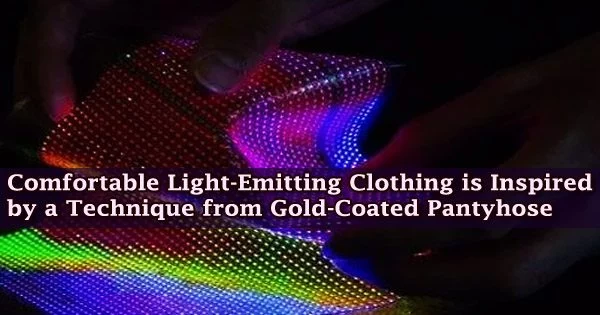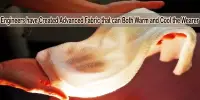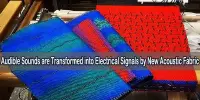Researchers from Canada publish March 4 in the journal Matter that a method for creating light-emitting fabric based on standard ultrasheer pantyhose coated in a thin gold layer may enable the production of softer, more wearable luminous clothing.
With reliable power sources, the work could be developed into more practical designs for safety gear worn by first responders and nighttime construction workers, light-emitting athletic apparel, avant-garde and regular fashion, or wearable advertisements and logos. The work addresses some of the limitations of existing light-emitting fabrics.
“Users want light-emitting displays that are integrated into fabrics so that they are soft, lightweight, stretchable, washable, and wearable just like ordinary clothing but with light-emitting panels that can illuminate the user or display graphics/information,” says senior author Tricia Carmichael, a professor of surface and materials chemistry at the University of Windsor.
It has been difficult to create wearable materials with a high-tech twist, though. The fabrics used in clothes are far from stiff, with their interwoven yarns made to move and stretch, unlike the solid surfaces of glass, silicon wafers, or plastics, for which the existing manufacturing techniques are ideally suited.
Because of this, existing methods for creating light-emitting clothing entail stitching rigid wires, optical fibers, and diodes into textiles. As a result, the resulting clothing lacks the stretchability and softness of its non-luminous equivalents. They are also difficult to wash.
Carmichael and colleagues adopted a new strategy after realizing the significance of incorporating light-emitting elements into these elastic and flexible structures in order to create luminous garments that feel like any other clothing.
We are optimistic about the ability to scale up the technology. The process we use to deposit the ultrathin gold coating on fabric fibers can be scaled up by increasing the volume of the plating solution, enabling processing of entire articles of clothing. We also use existing ultrasheer fabrics and thus do not require new textile manufacturing.
Professor Tricia Carmichael
“The lead author on the present paper, Yunyun Wu, was out shopping for fabrics for her research and had a eureka moment: why not use sheer fabrics as a solution for forming the transparent conductor, a crucial element of all light-emitting devices?” says Carmichael. “A second lightbulb moment came when we thought of pantyhose as an ideal material to build the new electrodes.”
In order to coat pantyhose with a highly conductive gold film only about 100 nm in thickness, the researchers used electroless nickel-immersion gold metallization, a solution-based metal-deposition technique frequently used to make printed circuit boards that only deposits metal on the nylon and spandex fiber surfaces.
They discovered that the coating procedure allowed the pantyhose fabric to keep its stretchiness and degree of transparency. The researchers next developed patterned light-emitting textiles with the smiley-face emoji using this new fabrication method, as well as a dynamic display made of seven rectangular pieces that can be rearranged to display the digits 0 through 9.
Despite the fact that gold might be expensive, Carmichael and colleagues think that it is a fantastic material for wearables due to its chemical stability and skin safety.
The researchers are not concerned about the price of the metal or other expenditures connected with scaling up production because such a small amount of gold is required to imbue textiles with the conductivity they need to light up (a covering 1,000 times thinner than a human hair).
“We are optimistic about the ability to scale up the technology,” says Carmichael. “The process we use to deposit the ultrathin gold coating on fabric fibers can be scaled up by increasing the volume of the plating solution, enabling processing of entire articles of clothing. We also use existing ultrasheer fabrics and thus do not require new textile manufacturing.”
The inability to power wearable light-emitting devices without clunky energy producers and storage systems, however, remains a significant barrier to their widespread adoption in daily life.
“We are exploring the wide variety of textile architectures as an integral part of device electrode design to enable the seamless integration of brittle energy storage materials into textiles,” says Carmichael.
















